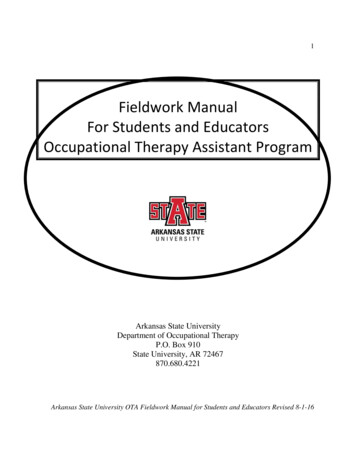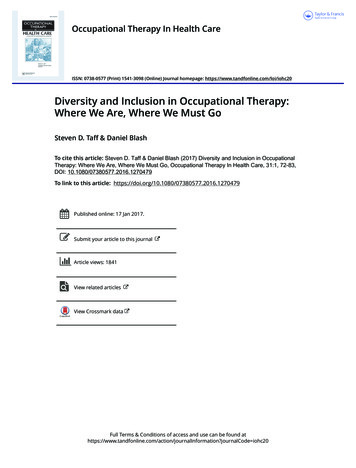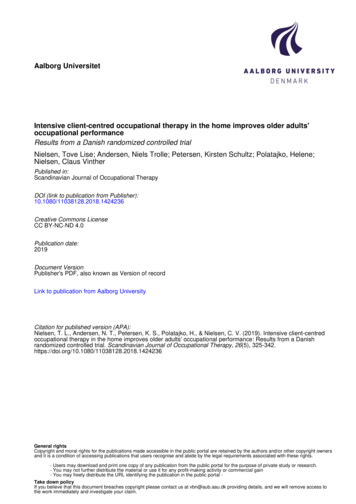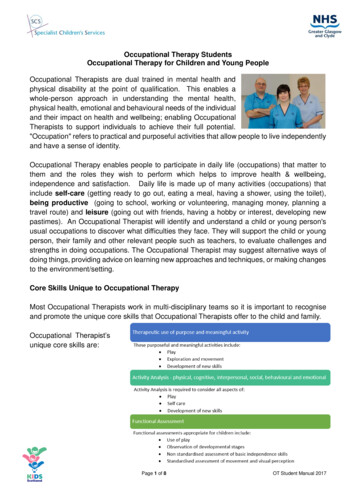
Transcription
OCCUPATIONAL THERAPY AND PRIMARY CARE:A VISION FOR THE PATH FORWARDCatherine Donnelly, Leanne Leclair, Carri HandPamela Wener, Lori LettsCanadian Association of Occupational Therapists
Disclaimer: The following is a proposal of a vision of occupational therapy practice—one that wesuggest will bring about the utmost benefit for Canadians. Roles and recommendations reflected inthis document assume the possibility of other approaches or practices also being relevant and important to the discussion. In conjunction with these recommendations, occupational therapists mustabide by provincial regulations that govern occupational therapy practice and integrateclinical judgment and other factors, including client preferences and resource availability.We would like to acknowledge the following individuals who supported the completion of this work:Hal Loewen, Ashley Youssiem, Monica Kapac, Danielle Degagne, Anna Tjaden-McClement, SwantiDuet, Amanda Mofina, and Ashley Williams. Occupational Therapy and Primary Care: A Vision for the Path Forward 1
OCCUPATIONAL THERAPY AND PRIMARY CARE:A VISION FOR THE PATH FORWARDINTRODUCTIONPrimary care in Canada has undergone significant transformation in the past 20 years. Canada’spopulation is aging, and chronic health conditions are now the leading cause of disability and death(Public Health Agency of Canada, 2017). Models of interprofessional primary care in Canada support the changing demographics and provide more comprehensive and coordinated care (Collegeof Family Physicians of Canada, 2020; Hutchison et al., 2011). The vision for primary care in Canadais a patient medical home with team-based primary care as its foundation (College of Family Physicians of Canada, 2020). Primary care is the first point of contact with the health care system andis defined as “the element within primary health care that focusses [sic] on health care services,including health promotion, illness and injury prevention, and the diagnosis and treatment of illnessand injury” (Health Canada, 2012, para. 1). Core elements of primary care are: a client-centred focusdelivering service as the first point of contact when a health issue arises, care that is longitudinal orprovided over time to a defined group of individuals, services that are comprehensive, and coordination of care when services are required elsewhere (Starfield, 1994). As it is the place of entryinto the health system, concepts of health equity and access are important to consider in relation toprimary care (Glazier, 2007). A strong primary care system is considered the cornerstone of a highfunctioning health care system (Starfield et al., 2005). This document defines key characteristicsof occupational therapy in primary care, describes the ways in which occupational therapy hasbeen practiced in primary care, and presents a vision for the future of occupational therapy inprimary care.As a primary care service, occupational therapists work as part of a team of primary care providersand strive to enact the core principles of primary care. The goal for occupational therapy in primarycare is to offer Canadians direct and first access to occupational therapy and provide services longitudinally, with the potential to serve a population of clients and follow these individuals over theirlifespans. With no distinct admission or discharge, individuals are seen when there is a change orpotential change in their abilities to participate in everyday life activities and occupations. As generalists, occupational therapists offer comprehensive services across all ages and diagnoses. Occupational therapists also facilitate coordination of services both within the team and with communityservices. Table 1 provides an overview of the key features of primary care applied to occupationaltherapy. Occupational Therapy and Primary Care: A Vision for the Path Forward 2
Table 1Key Features of Primary Care Applied to Occupational TherapyKey FeaturesKey Features for Occupational Therapy in Primary CareFirst contactOccupational therapists work in a site or have a primary affiliation with asite that provides first contact services (e.g., general practitioner’s office,community health centre).LongitudinalOccupational therapists have the potential to provide long-term and continuous services. While the nature of the services described may be short term,the patient is not discharged from primary care services and is part of thepractice’s list of patients/clients.ComprehensiveThe occupational therapist may provide a discrete and focused service buthave the capacity and potential to work to full scope and provide the fullbreadth of occupational therapy assessment and interventions to all patients.For example, services may involve a clinic for falls, but as part of a more comprehensive suite of services.CoordinatedThe occupational therapy service is a package of services that are aimed atcoordinating care for patients.Occupational therapy makes important contributions to primary care. There is growing evidencethat occupational therapists’ unique lens supports individuals with or at risk of disability in aprimary care environment (Cassidy, Richards, Eakman, 2017; Connelly, Anderson, Colgan,Montgomery, Clarke & Kinsella, 2018; Cook & Howe, 2003; Garvey et al., 2015; Gustavsson, Norlander& Soderlund, 2018; Joahansson, Jonsson, Dahlberg & Patomella, 2018; Richardson et al., 2012;Richardson et al., 2010; Schepens et al., 2019). Occupational therapy has often been synonymouswith rehabilitation and facilitating recovery from injury, illness, or disease. However, the scope ofoccupational therapy goes well beyond recovery to include health promotion, disability and diseaseprevention, and community development (Metzler et al., 2012). All of these perspectives are wellaligned with primary care.The vast majority of Canadians address their health care needs in primary care settings(Jaakkimainen et al., 2006). As interprofessional primary care teams expand, opportunitiescontinue to emerge for occupational therapy to contribute to client health and wellbeing in thiscontext (College of Family Physicians of Canada, 2020). Occupational therapy associationsaround the globe, including in Canada, the United States, and Europe, are recognizing theimportance of examining the profession’s role in primary care, with position statements andclinical guidelines published or in development (Donnelly et al., 2022). Canada is an internationalleader in primary care occupational therapy, with occupational therapists working in team-basedprimary care models and researchers building evidence in the field.One of the biggest challenges of occupational therapy’s integration into primary care is that occupational therapists themselves do not always understand primary care and its philosophies. As aresult, there is a risk of simply transferring approaches used in community and institutional settings,rather than building evidence and models of practice that can support occupational therapists in Occupational Therapy and Primary Care: A Vision for the Path Forward 3
developing new primary care service delivery models, roles, and practices (Tse, 2003). Primary carecontinues to be the major focus of health system transformations and is the backbone of integratedcare models. Occupational therapists have the opportunity to play an important role in this growingarea of practice. However, it is crucial that occupational therapists develop roles that are built onevidence and a clear understanding of the service delivery context.CURRENT OCCUPATIONAL THERAPY IN PRIMARY CAREIn a recent scoping review examining occupational therapy in primary care, multiple interventionswere identified across the lifespan, highlighting both the depth and the breadth of the professionin this setting (Donnelly et al., 2022). The following provides a summary of roles for occupationaltherapy in primary care as they are being conceptualized or implemented.1. Across all client age groups, occupational therapists working in primary care:a. Bring a unique focus on occupationb. Emphasize interventions directed at health promotion and primary and secondarydisease prevention (e.g. self-management)c. Engage in collaborative goal setting with individuals, families and communitiesd. Link individuals of all ages to community services, programs, and resourcese. Target occupation-level outcomes with an emphasis on increasing and optimizingparticipation and performance in everyday activities2. When working with children and youth, occupational therapists:a. Conduct developmental screening and assess physical, affective, and cognitive abilitiesb. Support parent and child interactionsc. Facilitate occupational participation (e.g., play).3. When working with adults and older adults, occupational therapistsa. Assess physical health (e.g., hand function, range of motion, strength, sensation, seating),mental health (e.g., mood, psychological wellbeing), occupations, and physicaland social environmentsb. Employ person-level strategies to support physical well-being (e.g., activity, exercise,fatigue management) and mental well-being (e.g., cognitive-behavioural techniques,counselling, coping and social skills)c. Enable the management of chronic diseases, using occupation-focused andgoal-based approaches4. When working with adults, occupational therapists:a. Assess physical and mental health, lifestyle and everyday activity patterns, workcapacity, and workplace accommodationsb. Support individuals at work or returning to work through ergonomics accommodations,and work-based coping strategies and skillsc. Provide interventions related to the grading, adapting, or sequencing of activitiesd. Offer strategies for adaptation to both physical and social environmentse. Facilitate access to benefits and financial resourcef. Provide lifestyle modifications and health and wellness activities Occupational Therapy and Primary Care: A Vision for the Path Forward 4
g.h.Prescribe adaptive aids, assistive technology, and equipment for home, workand the communityUtilize an integrated approach drawing on person-, occupation-, and environmentlevel interventions to enable individuals to manage chronic pain, manage stress,promote health, and prevent illness and disease (e.g., self-management)5. When working with adults and older adults, occupational therapists:a. Assess cognition and perception, mobility, and drivingb. Conduct home safety assessments and recommend home adaptations tosupport aging in the communityc. Offer family and caregiver supportd. Provide education on community resourcese. Implement falls prevention through an integrated approach that draws on person-,occupation-, and environment-level interventionsOccupational therapists working in primary care cover the full scope of occupational therapy practice and provide services to individuals across the lifespan. Devereaux and Walker (1995) describedprimary care occupational therapists as generalists, and the generalist role is clearly demonstratedin the literature (Donnelly et al., 2014; Donnelly et al., 2016). Given the breadth of primary care, ageneralist role is expected and suggests that occupational therapists have the potential to workto their full scope of practice in this setting. The findings have also clearly demonstrated that theelements of primary care described by Starfield (1994) guide the role of primary care occupationaltherapists—providing care across the lifespan that is comprehensive in nature, spanning the person,occupation, and environment domains.REFLECTING ON THE ROLE OF OCCUPATIONAL THERAPY INPRIMARY CAREProximity to Primary CareIn 2011, Letts posed three questions to members of the occupational therapy profession to consider when looking to expand their roles into primary care. The first question asked: How proximal isoccupation to the occupational therapy role? Letts suggested that services proximal to occupationfocus in important ways on occupational engagement, as a means or end of occupational therapyservices. She concluded that occupation is proximal to the work of occupational therapists in primary care, and as such primary care is an optimal setting for developing occupational therapy roles.Research reinforces that occupation is in fact at the centre of primary care occupational therapy,integrated with person and environment. Common interventions adopting this holistic approachinclude chronic disease management, self-management, health promotion, and falls prevention.One of the arguments made for the integration of occupational therapy in primary care is ultimatelythe profession’s focus on occupation—the ability to consider the person holistically, understandingthe intersections of person-level factors, daily function, and environmental contexts. Interprofessional models of primary care are relatively new and were designed specifically to address the increasingly complex issues associated with an aging population and a growing number of people withone or more chronic diseases. Older age and chronic disease are associated with higher use of thehealth care system (Rosella, et al., 2014), as well as challenges in everyday function and health status(Richardson et al., 2012). Occupational Therapy and Primary Care: A Vision for the Path Forward 5
It has been said that one of the issues key to managing chronic disease in primary care is ensuringthe right services are directed to the appropriate individuals, at the right time. Wallace andSiedman (2006) described three groups of clients in primary care, which are frequently presentedin the Kaiser Permanente Population Health Risk Pyramid. The first group includes individuals whohave little interaction with the health care system and who, with the right supports, can effectively manage their own health. This first group is said to account for approximately two thirds of theindividuals in primary care and would most benefit from self-management approaches. The secondgroup comprises approximately 20% of a primary care caseload and includes individuals who haveone or more chronic conditions and are at risk of further decline. Targeted team-based approachesand chronic disease management are best suited for this intermediate second group. The third andfinal group represents a small portion of individuals, approximately 5% of the total caseload, whohave multiple chronic conditions and complex needs and who would benefit from a higher intensitycase management approach. It has been shown in multiple jurisdictions in Canada that individuals inthis last group of primary care clients have the highest health care use and account for the majority,upwards of 60%, of total health care costs (Rais et al., 2013; Rosella et al., 2014).For primary care occupational therapists, it is important to understand the needs of different populations served in the primary care setting and provide services that are appropriate to their needs.This understanding will ensure that their roles are both developed and deployed appropriately, andthat occupation will be at the forefront of services. Health promotion was one of the most frequently identified interventions in the non-research literature reviewed for the scoping review (Donnelly etal, 2022). Health promotion is not so much a specific role, but rather a perspective. Wilcock (2006)stated that “an occupation-focused approach to health promotion involves enabling people to increase control over, and to improve, their health and that this can be attained through doing (occupations)” (p. 313). Shifts in demographics to an aging population have also led to a greater emphasison health promotion and recognition of the social determinants of health.The roles that have been identified in the scoping review (Donnelly, et al., 2022) can be viewedfrom a health promotion framework. Wilcock and Hocking (2015) presented four levels of healthpromoting occupational therapy, which map nicely onto the Kaiser Permanente Population HealthRisk Pyr amid and offer guidance as to which interventions are best suited for specific populationsin primary care. Level one is directed to the general public, or to the bottom layer of the pyramid,focusing on promoting health and preventing injury and illness. The roles at this level would includedevelopmental screening, falls risk assessments and prevention, injury prevention, driver screening,and promotion of healthy occupations and behaviours.Level two, or the middle of the pyramid, includes individuals who currently experience health issues,who may benefit from interventions to influence behaviour change and to slow down or preventfurther disease and disability. A large number of the roles identified in this review fall into this level.Included here are lifestyle modifications, promotion of healthy habits and routines, and chronicdisease self-management activities including joint protection, energy conservation, home exercises,counselling, pain management, and ergonomics.The third level, or top of the pyramid, addresses those individuals with chronic disease and disability,aiming to maintain health and wellbeing. Occupational therapists most often work with this population, and a range of roles fit here, including prescription of assistive technology, home modifications, supporting access to disability supports and benefits, transportation, mobility interventions,caregiver support and education, facilitating return to work, and supporting children’s occupationalparticipation. Occupational Therapy and Primary Care: A Vision for the Path Forward 6
The final level is directed toward end-of-life care, supporting quality of life (QOL). While there were fewer rolesidentified for this level, there was a clear identification of the role for occupational therapy to offer end-of-lifecare and support for families and caregivers.Figure 1 provides a visual overview of how occupational therapists working in primary care can bring in a healthpromotion lens to support different segments of the primary care population.Figure 1Health Promotion Lens in Primary CareIndividuals atend of lifeMaintain, optimize and enhance QOL, healthand well-beingIndividuals, groups andcommunities with complex health,functional and social needsIndividuals, groups and communitieswith health, functional and social needsMaintain, optimize and enhanceparticipation and functionPromote health, prevent disease forindividuals, groups and communitiesIndividuals, groups and communities who arefunctioning in their everyday activities and rolesAddressing social determinants of health health equity throughoutto optimize occupation and participationIt is clear that occupation is in fact central to assessment, intervention, and outcomes in theoccupational therapy primary care research literature. Primary care is a practice setting thathas almost exclusively been physician based, and therefore a biomedical model is by far thedominant practice framework. With the increased growth in primary care teams, there is arecognition of a broader perspective on health, and occupational therapists are well positionedto bring a unique and occupation-centred perspective to the primary care team. Additionally,there is an increasing emphasis on integrated health systems, and occupational therapists canplay a key role in integrating more than traditional health services to support participation andwellbeing, such as by including the social, educational, and justice sectors.Strength of the evidenceLetts (2011) posed a second question to the profession: How strong is the evidence to support occupational therapy in the role? It is fair to state that the evidence supporting occupational therapyin primary care is emerging and promising. Of the 92 papers included in a recent scoping review(Donnelly et al., 2022), only a handful would be considered as providing strong evidence. The strongest evidence exists for interventions targeting adults and older adults living with chronic conditions and supporting older adults and their caregivers in their homes and communities. Much of theearly literature used to support the role of occupational therapy in primary care drew on peripheral Occupational Therapy and Primary Care: A Vision for the Path Forward 7
evidence-research that could inform the role, undertaken with relevant populations, but not directlyconducted in a primary care context. In fact, many recent non-research papers that call for occupational therapy in primary care still largely rely on evidence gathered in non-primary care settings(e.g., Jordan, 2019; Occupational Therapy New Zealand Whakaora Ngangahau Aotearoa, 2016). Theevidence may be strong, be based on well conducted studies, and in fact be transferable to primary care; this may be especially true when considering the interventions typically delivered to theapproximately 5% of the populations served in primary care who are at the top of the Health RiskPyramid. For those people, who typically have disability and multiple conditions, the evidence abouteffectiveness of occupational therapy interventions may be transferable to delivery in a primary carecontext, because the interventions themselves may be very similar regardless of the delivery site.However, it must also be understood that primary care is a unique setting, and what might be effective in other practice settings may not work in primary care.By explicitly considering the key elements of primary care as identified by Starfield (1994), occupational therapy research can more consciously evaluate its applicability to this practice setting.Given the diversity in health care services and models of practice internationally, lack of knowledgeregarding the specific setting in which a particular study was carried out continues to be a majorchallenge in assessing the evidence supporting the occupational therapy role in primary care. Wefeel that context matters, and there is a need to consider the health service delivery setting whenevaluating the literature to determine which evidence may be directly informative and which areasrequire further research. When considering the range of preventive, self-management, and healthpromotion interventions that could be delivered to people in the bottom and middle portions of theHealth Risk Pyramid, it may be particularly important to evaluate intervention effectiveness whendelivered by occupational therapists in primary care settings. The longitudinal nature of primarycare, along with interprofessional team contexts, may influence the effectiveness of these healthpromoting and preventive interventions. In addition, in considering the needs of children and youthfor occupational therapy in primary care, there has been little attention to either examining researchthat might inform the primary care role or to the creation of evidence specifically in primary caresettings.Another challenge with the current state of primary care occupational therapy literature is the heavyreliance on expert opinion. As a result, many of the occupational therapy roles identified are notlinked directly to research, but to possibilities. In order to firmly establish ourselves as team members with important contributions, we need to shift our attention to conducting research in this areaand to ensure our recommendations for the role are linked directly to evidence. The evidence specific to occupational therapy in primary care has doubled in the past five years and demonstratesthe expansion of this role in Canada, the United States, Netherlands, UK and Australia. Primary careoccupational therapy is an area of tremendous research opportunity. Moving forward, researchersneed to be clear in the description of the primary care setting and provide context regarding healthcare models or services.Timing for Occupational Therapy in Primary CareThe third and final question Letts (2011) proposed to the profession was: Is the timing right forchange? Ten years have passed since Letts’ article was published, and primary care remains at thetop of the agenda in health care in Canada and internationally. As the population ages and chronicdisease continues to be a major focus in primary care, a team-based approach will be key to supporting Canadians. The College of Family Physicians of Canada has clearly stated its vision of a“Patient’s Medical Home,” in which team-based primary care is a foundational element (2020). Occupational Therapy and Primary Care: A Vision for the Path Forward 8
Figure 2A new Vision for Practice: Patient’s Medical HomePrinted with permission: College of Family Physicians of Canada. (2020). A new vision for practice:The Patient’s Medical Home. https://patientsmedicalhome.ca/Health care reforms across the globe have looked to primary care as a way to increase accessto services and enhance client/patient outcomes. There is evidence across countries that strongprimary care is the marker of a strong health care system (Starfield et al., 2005), and primary caresystems have been called the “anchor” of health care (Ontario Government, 2012). In a 24-hourtimeframe, 137,000 visits were made to primary care (family physicians), and in this same 24 hoursthere were 3,000 hospital admissions and 50 hip and knee replacements in the province of Ontario(Jaakkimainen et al., 2006). Over the course of the lifespan, the average Ontarian will spend 355days in primary care, 116 days in emergency, and eight days in hospital (Jaakkimainen et al., 2006).Primary care is where most people interact with the health care system. Occupational therapists aretypically working in only select areas of the system where the smallest proportion of the populationreceives services, though we are seeing a shift.Primary care teams are expanding, and every province has embraced the Patient’s Medical Homemeaning there is potential for teams in every province. This is a crucial time for occupational therapists to not only have a clear understanding of our role in primary care settings, but to be able to Occupational Therapy and Primary Care: A Vision for the Path Forward 9
articulate the role to decisionmakers and provide strong evidence of our ability to positively impactCanadians’ health and wellbeing.Occupational therapists can make important contributions in primary care with a role that is proximal to occupation, with evidence that is promising, and continued focus on interprofessional primary care suggesting that there is a need for ongoing efforts to ensure solidification and furtherexpansion of occupational therapy in primary care contexts across the country.THE VISION FOR OCCUPATIONAL THERAPY IN PRIMARY CAREOur vision for the future of the role of occupational therapy in primary care includes the following:1.2.3.4.5.6.7.Ensuring access to occupational therapy in primary care: All Canadians will have access tooccupational therapy services through primary care, while ensuring coordination withoccupational therapy services in other practice contexts to limit duplication of serviceswhile promoting health systems integration and continuity of care.Enabling a just society: Occupational therapists in primary care will ensure equitable accessPracticing to full scope: Occupational therapists in primary care settings will work to their fullscope of practice as generalists to support individual, family and community participation.Building evidence: Research will examine the effectiveness of occupational therapy servicesdelivered in primary care contexts, targeting all three levels of the Health Risk Pyramid(Wallace & Siedman, 2006). While research should be conducted across the lifespan particularattention should be given to the roles and effectiveness of occupational therapy services toenable occupations of children and youth and their families in primary care.Advocating for occupational therapy in primary care: Interprofessional teams are core topatient medical homes which are the foundation of an integrated health care system.Occupational therapy associations and individual therapists will reinforce the uniquecontributions of occupational therapy in primary care teams and their role in supporting anintegrated health system.Educating occupational therapy students: Opportunities for occupational therapists to workin primary care will continue to expand. Entry to practice occupational therapy programswill prepare student occupational therapists for generalist roles in primary care withknowledge of the unique elements of this practice setting and their roles in supportinghealth systems integration.Educating occupational therapists: Evidence unique to primary care occupational therapycontinues to expand. Continuing professional development opportunities specific tooccupational therapy in primary care will ensure current evidence is disseminated andsupports occupational therapists’ work in this setting. Occupational Therapy and Primary Care: A Vision for the Path Forward 10
REFERENCESCassidy, T. B., Richards, L. G., & Eakman, A. M. (2017). Feasibility of a Lifestyle Redesign –inspiredintervention for well older adults. American Journal of Occupational Therapy, 71, 7104190050.https:// doi.org/10.5014/ajot.2017.024430College of Family Physicians of Canada. (2020). A new vision for practice: The Patient’s MedicalHome. https://patientsmedicalhome.ca/Connelly, D., Anderson, M., Colgan, M., Montgomery, J., Clarke, J., & Kinsella, M. (2018). The impact ofprimry care stress management and wellbeing program (REVEW) on occupational participation: Apilot study. BJOT, 1-10Cook, S., & Howe, A. (2003). Engaging people with enduring psychotic conditions in primary mentalhealth care and occupational therapy. British Journal of Occupational Therapy, 66, 236–246.https:// doi.org/10.1177/030802260306600602Donnelly, C., Leclair, L., Hand C., Wener, P., & Letts, L. (2022). Occupational therapy in primary care:A scoping review [In press].Primary Health Care Research and
breadth of occupational therapy assessment and interventions to all patients. For example, services may involve a clinic for falls, but as part of a more com-prehensive suite of services. Coordinated The occupational therapy service is a package of services that are aimed at coordinating care for patients. Table 1











